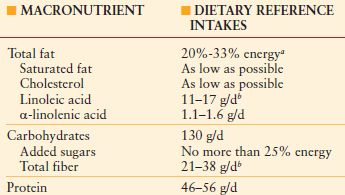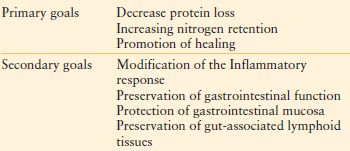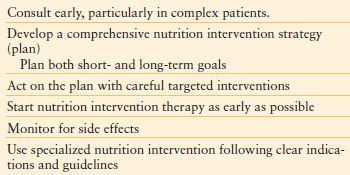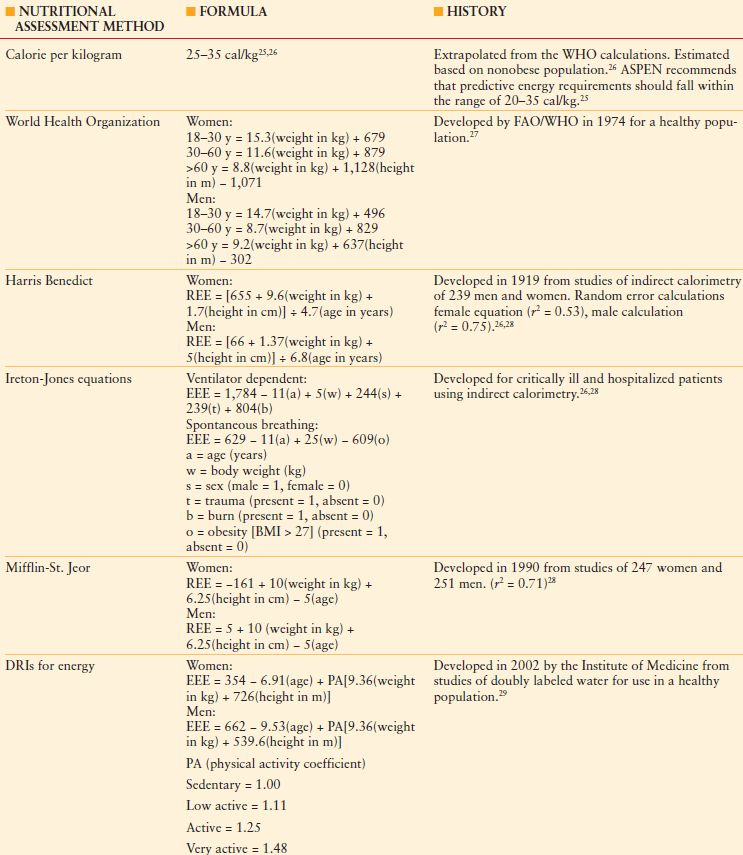CHAPTER 11

Nutrition in Acute Care Surgery
Modern care of the acutely ill surgical patient cannot be conceived without the provision of adequate nutrition. Nutrition has evolved far beyond that of being solely “supportive.” Nutrition intervention therapy, in addition to providing the necessary nutrients to maintain normal metabolic processes, plays other essential roles including maintenance of mucosal integrity, modulation of immune responses, and protection against oxidative stress, among others. Nutrition intervention therapy is a powerful tool for the acute care surgeon that, when used adequately, beneficially affects patient outcomes; conversely, when poorly applied, it can cause increased morbidity and mortality and increase cost.1 This chapter reviews the basic principles to assist the clinician with successful utilization of nutrition intervention.
Humans need food, water, and electrolytes. When digested and absorbed by the gastrointestinal tract, nutrients provide the basic elements to meet the energetic and metabolic needs for normal activity, growth and repair of cells and tissues. Under normal circumstances, a human adult is capable, through the process of eating and drinking, of ingesting a balanced amount of nutrients to meet his/her daily needs. This process occurs naturally and is regulated by physiologic processes such as hunger, thirst, and craving. Notwithstanding the epidemic of obesity, most humans achieve an equilibrium maintaining adequate hydration and electrolyte balance while satisfying the needs of macro- and micronutrients.
Eating and drinking are dramatically disrupted in the acutely ill surgical patient, obligating the clinician to replace the natural process of food intake. Balanced intravenous electrolyte solutions resolve most needs for water and electrolyte replacement and thus permit moderate periods of starvation. Ideally, resumption of oral intake is possible within a short amount of time after injury or operation; being the “golden standard,” spontaneous normal eating should be allowed whenever possible.
Until 1968, a patient without a functional gastrointestinal tract was condemned to die of starvation. Evidence that total parenteral nutrition (TPN) could maintain normal growth and activity of growing pups ushered in the modern era of nutrition.2 TPN coupled with the continued growth and sophistication of enteral diets now permits the provision of adequate nutrition intervention therapy so that normal cellular activities and tissue growth and repair can proceed. Despite its progress, any form of nutrition intervention, other than promotion of spontaneous oral intake, is artificial and does not replace the physiologic process of eating. Also, the nutrients provided by either TPN or total enteral nutrition (TEN) cannot be mistaken for normal food intake. As such, nutrition intervention therapy is comparable to other form of medical therapy and is associated with benefits when adequately ordered and delivered; side effects, some of which can be unexpected; and risks including severe complications and even death.
NUTRIENT UTILIZATION DURING NORMAL STATES OF HEALTH
The purpose of the creation of nutritional requirement guidelines has been the optimization of the human diet. Recommended dietary allowances (RDA) were developed by the government to sufficiently cover the nutritional requirements of most individuals (97% of the population). The Dietary Reference Intakes (DRIs) recommendations were introduced in 1997 to broaden the RDA. The DRIs include the RDA as well as adequate intakes (AIs) to provide guidance for those nutrients for which there is no RDA (i.e., vitamin D, vitamin K, fiber) or acceptable macronutrient distribution range to describe the range of intake for a particular energy source that is associated with reduced risk of chronic disease while providing intakes of essential nutrients (i.e., fat).3 Human nutrition requirements vary widely from individual to individual depending upon multiple variables including age, gender, activity, and presence of illness. Despite their limitations, published RDA and DRI for normal states of health have provided the basis for comparisons of what is needed in the acutely ill surgical patient (Table 11.1).3
TABLE 11.1
RECOMMENDED INTAKES FOR MACRONUTRIENTS

NOTE: Amounts above are recommended for men and women from ages 19 to 70.
a Acceptable macronutrient distribution range.
b Adequate intake.
Source: Insitute of Medicine. Food and Nutrition Board. Dietary Reference Intakes for Energy, Carbohydrate, Fiber, Fat, Fatty Acids, Cholesterol, Protein, and Amino Acids (Macronutrients). Washington, DC: National Academy of Sciences; 2005.
Protein balance (also called nitrogen balance) is a result of equal intake versus protein loss. Average healthy male adult intake necessary to maintain nitrogen balance is 0.75 g/kg/d.3 Proteins (and amino acids) are the sole source of nitrogen, which can be measured in different nutrients, in tissues, and in urine. The average nitrogen conversion factor for mixed foods is 6.25 and is utilized universally to determine protein content. Protein losses include shed skin, losses in stool, and losses in urinary nitrogen that occur as a result of normal protein turnover.
Protein turnover is governed by anabolism and catabolism, two independent and carefully regulated processes, and balance is achieved when the same amount of protein is deposited as is broken down. Within the catabolic process, protein is broken down into amino acids. Approximately 80% of the amino acids are utilized back for the formation of new protein with loss of the remaining 20%. Illness alters both protein catabolism and anabolism in different ways. Generally, illness leads to a negative nitrogen balance, meaning that protein catabolism predominates over that of anabolic processes.
Investigators have identified several protein compartments in the body including skeletal, visceral, and circulatory compartments. Skeletal muscle constitutes a primary source of protein during stress, and its destruction is prioritized to protect visceral protein (defined as the protein compartment contained in vital organs). Plasma circulating proteins including albumin and prealbumin, although small as a compartment, are important in that they have been used as biomarkers of nutritional status. However, synthesis of albumin and prealbumin is profoundly affected by inflammatory states, and changes in their plasma concentrations are not specific to the nutritional status of the patient during acute illness, thereby limiting their value as reliable biomarkers of nutrition status.4
Protein can be used as an energy source roughly providing a similar amount of calories per gram as that of carbohydrates. In the absence of carbohydrate intake, certain amino acids contained in protein (e.g., alanine) become obligate sources of glucose (gluconeogenesis), an essential process during prolonged fasting.
Lipids perform multiple essential functions; they are essential for the cell membrane architecture, serve as the substrate for the formation of signaling molecules and hormones, and are the most important source of energy storage. Healthy myocardium primarily uses fatty acids as its energy source.5,6 Lipids often become the primary source of energy during acute surgical illness.
Glucose is an essential compound for cell function providing energy for anaerobic and aerobic metabolism. Several tissues including erythrocytes, the brain, and parts of the renal parenchyma are obligate users of glucose. Small amounts of glucose can be stored in the muscle as glycogen, although these stores are exhausted within the first 48 hours of fasting. Dietary carbohydrates, which include monosaccharides, disaccharides, and polysaccharides, vary considerably in their presentation with more complex carbohydrates, such as starch, forming chains of monosaccharides. Glucose, a monosaccharide, is readily absorbed into the circulation while complex carbohydrates require enzymatic breakdown (e.g., amylase) before absorption. The impact of a dietary carbohydrate on circulating glucose (and therefore insulin release) is called the glycemic index (GI) and is inversely proportional to its complexity. The GI value is derived from the area under the curve for the increase in blood glucose after the ingestion of a set amount of carbohydrate in a food during the 2-hour postprandial period.7 Complex carbohydrates require a functional gastrointestinal tract for their absorption and digestion while glucose can be delivered directly into the circulation as in TPN. The rate of breakdown and absorption is proportional to the rise in circulating blood sugar and subsequent insulin response. For this reason, GI is often used to calculate the glycemic load, an indicator of glucose response or insulin demand that is induced by total carbohydrate intake. It is calculated by multiplying the weighted mean of the dietary GI by the percentage of total energy from carbohydrate. The utilization of GI in combination with glycemic load is important in patients with insulin resistance or underlying diabetes mellitus.8
Micronutrients are also essential for survival. Micronutrients include vitamins, co-vitamins, and minerals. All micronutrients are contained in a balanced diet, although specific deficiencies may be observed with relative frequency. In addition, disease imposes the need for supraphysiologic supplementation of specific micronutrients (Table 11.2). The importance of micronutrients in management of the acutely ill surgical patient cannot be overstated, although an exhaustive discussion of this topic goes beyond the scope of the chapter. We provide a partial list of most frequently mentioned micronutrients to raise awareness of their importance.3,8–11
TABLE 11.2
SELECTED MICRONUTRIENT REQUIREMENTS

NUTRIENT UTILIZATION DURING ACUTE SURGICAL ILLNESS
Survival in the acutely ill surgical patient is influenced by neuroendocrine and immune activation including the release of inflammatory signals. As a result, noticeable metabolic changes include an increased catabolic response, hyperglycemia, appreciable alteration in lipid utilization as an energy source, changes in synthesis and breakdown of visceral proteins, and alterations in the availability of certain micronutrients, such as amino acids and iron.
Increased protein catabolism that exceeds anabolic responses is a hallmark of the catabolic response of physical injury, be it trauma or surgery.12 Protein losses (negative nitrogen balance) are higher than those observed with a simple starvation response. Following surgery, muscle is used as an essential source of amino acids necessary for the generation of glucose and for tissue repair and healing. Skeletal muscle serves the purpose of being the “protein store” of the body; during prolonged illness, protein becomes the “limiting” macronutrient often long before exhaustion of lipid stores ensues. As a result, protein depletion following acute care surgery leads to severe malnutrition and muscle deconditioning.13 Thus, the major focus of nutrition intervention therapy is achieving a positive nitrogen balance as a means to prevent protein malnutrition and improve outcome.
There have been many attempts at restoring protein anabolism in the acutely ill through the provision of increased amounts of calories and protein above that of the daily normal requirements. These therapeutic strategies have been called by different names including hyperalimentation or the correction for “stress factors” that are artificially used to calculate increased metabolic requirements. The use of TPN has been a preferred treatment strategy, as it is easy to provide large amounts of calories through this route. These well-intentioned strategies have, however, failed to show benefit and in some cases are known to produce harm.14 Failure to achieve positive nitrogen balance through dietary means alone has forced nutrition investigators and surgeons alike to focus on control of inflammation as a means to reverse the catabolic response.
The immune (inflammatory) response to acute surgical illness plays a key role in the catabolic responses observed in acute care surgery. Tumor necrosis factor, initially known as cachectin, increases muscle breakdown. Interleukin-1 increases metabolic rate and generates a febrile response. The rate of protein catabolism and negative nitrogen balance is proportional to the severity of the inflammatory response. As a result, progression towards protein malnutrition is accelerated in critically ill patients. Resolution of the inflammatory response leads to restoration between anabolic and catabolic processes and gives opportunity to an effective nutrition intervention therapy.
Insulin resistance often follows acute surgery and is frequently associated with hyperglycemia and poor utilization of glucose as an energy source. In addition, glycogen stores as a source of glucose are exhausted within the first 48 hours, making lipids a preferred fuel following surgery. The exhaustion of glucose along with insulin resistance obligates cells to utilize amino acids (particularly alanine and glutamine) as a mechanism for gluconeogenesis. Ketogenesis (from lipid oxidation) is also increased. Lipid mobilization is therefore observed, and it is common detect moderate amounts of hyperlipidemia in the acutely ill surgical patient. A depletion of circulating lipids and cholesterol is considered a marker of ensuing malnutrition and portends a poor prognosis.15
Little is known about the utilization of many micronutrients following acute care surgery. The use of supraphysiologic quantities of antioxidants and other micronutrients including selenium, zinc, and vitamin C have been suggested as an important adjunct to therapy in acute surgical illness. For example, vitamin C is now used routinely in high quantities during the resuscitation of burn patients. The results of ongoing studies are still not in, however, and therefore, prescription of high levels of these micronutrients should be reserved for the instances where they have found to be deficient.
The provision of the necessary substrate for cellular proliferation and repair and for the satisfaction of the energy needs in a given individual is an essential aspect of nutrition intervention therapy. As, such the acute care surgeon is obligated to provide a careful design and delivery of a well-balanced nutrition intervention.
THE PHYSIOLOGIC RESPONSE TO STARVATION AS A STARTING POINT IN THE DESIGN OF NUTRITION INTERVENTION THERAPY
Acutely ill surgical patients are often unable to maintain spontaneous food intake. As a result, many patients undergo periods of starvation, which can be prolonged at times. Starvation response has been used as a starting point to design nutritional intervention therapies. Starvation is a physiologic process. During times of famine, a series of carefully orchestrated genetic/metabolic responses occur aimed at preserving macro- and micronutrients to sustain normal organ function. The starvation response “buys time” for the individual. Several remarkable features are observed during starvation including that of decreased protein turnover (catabolism) and careful preservation of energy stores.
Obligatory protein loss in the normal individual is balanced through protein intake. As protein intake decreases, negative nitrogen balance ensues. However, in the starved individual protection of protein stores is achieved through a decrease in protein turnover.16 Thus, in the normal individual up to 15 g of nitrogen are lost per day and need to be replaced. An otherwise healthy human subjected to starvation will decrease nitrogen loss to approximately 5 g per day. This essential adaptive process protects muscle mass and prolongs the time to the development of malnutrition.17
Obligatory protein loss during starvation (5 g per day) is necessary for the generation of glucose and is essential for survival. Obligatory protein loss in starved individuals can be abrogated through the provision of small amounts of glucose (700 calories a day). This process is known as the protein-sparing effect of glucose and decreases muscle loss considearbly.
Preservation of energy during starvation is also remarkable.18 Starved individuals will spontaneously reduce their daily activities to meet the limited amount of energy intake. In addition, starved individuals will decrease their resting metabolic rate and thermal responses.17 This is probably secondary to decreased catecholamine turnover and action; and decreased peripheral conversion of thyroxine (T4) to the active triiodothyronine (T3).16 Clinical manifestations of decreased energy consumption are characteristic and include reduced interaction with the environment (apathy), hypothermia, and bradycardia.
Prolonged starvation inevitably leads to depletion of nutrients and the onset of malnutrition, a pathologic process characterized by organ dysfunction. Malnutrition negatively affects all disease processes and is associated with dramatic increases in morbidity and mortality. Malnutrition is surprisingly frequent in surgical and institutionalized patients, affecting up to one-third of patients. Attempts at its early identification and correction should be promptly instituted.
In contrast to the normal individual, acutely ill patients appear unable to mount a protective starvation response. As a result, progression towards malnutrition occurs more rapidly. In fact, patients with late multiple organ failure in the ICU will exhibit characteristics of severe malnutrition. Nutrition intervention therapy attempts to prevent the progression towards malnutrition observed in the critically ill.
STARVATION: A PHYSIOLOGIC PROCESS IN THE ACUTELY ILL?
Some short periods of starvation are almost inevitable in the acutely ill surgical patient. For example, care of hemodynamically unstable patients requires all attention toward stabilization. In this environment, nutrition intervention becomes secondary and is frequently forgotten. It is progressively clear, however, that acutely ill (particularly critically ill) surgical patients tolerate even modest starvation poorly. In fact, better outcomes including possibly decreased mortality are observed when nutrition intervention is started early—ideally within the first 24 hours of arrival to the intensive care unit.
NUTRITIONAL INTERVENTION HERAPY
The provision of nutrients necessary to support metabolic processes is essential for the acutely ill surgical patient. However, in addition to playing a “supportive role,” nutrition intervention plays essential therapeutic roles in prevention of muscle loss and increasing nitrogen retention, modulation of immune responses, and preservation of gastrointestinal function (Table 11.3).
TABLE 11.3
GOALS OF FEEDING

NUTRITION INTERVENTION TEAM; MORE THAN JUST THE DOCTOR
The continued process of specialization in the care of the acutely ill surgical patient requires specialized teams that, working together, result in improved outcomes for these complex patients. The push for specialization is a result of increased knowledge and technology along with complex social and economic reasons that encourage consultative processes rather than care by only one individual. Such is the case for the formation of acute pain support teams, the emergence of the infection preventionists, and the appearance of specialized nutrition support teams. It is essential to learn how to interact with these multiple teams to produce coordinated, seamless care. Traditional nutrition support, similar to other specialties, has evolved into complex nutrition intervention teams that deliver specialized nutrition intervention (Table 11.4).
TABLE 11.4
HOW TO USE SPECIALIZED NUTRITION INTERVENTION TEAMS

Nutrition education for medical students appears to be a logical and essential component of training. However, several studies have shown that there have been major deficiencies for decades.19,20 For example, only 25% of medical schools provide at least 25 hours or more of nutrition education to medical students during their entire 4 years of training.21 Formal nutrition education does not appear to improve during residency training either. Major deficiencies in physician knowledge on the topic of nutrition is by no means a problem limited to the United States as it has been also reported in other countries.
Nutrition support teams first evolved to provide technical and logistical support for the provision of TPN. Typically, these teams comprise a group of people with multiple disciplines including physicians, dietitians, pharmacists, nurses, and sometimes social workers. Nutrition support teams improve the quality of nutrition intervention therapy and prove cost-effective.22 Today, nutrition support teams focus their function on consulting services for optimization of enteral nutrition and prevention of the misuse of TPN.
HOW TO CALCULATE NUTRITIONAL GOALS
A considerable amount of research currently focuses on determination of the number and type of calories that should be provided to the acutely ill patient. It is interesting that such a basic question (i.e., how many calories should we order?) remains unanswered. Several observations demonstrate that the accumulation of a caloric debt (10,000 cal during the first week) is associated with increased morbidity and mortality.23 Most scientific societies and clinical guidelines advocate 20–25 kcal/kg/d, regardless of the patients’ metabolic state.1 These goals attempt to achieve a middle road between overfeeding and starvation. Ongoing prospective trials currently are underway and promise to better determine the ideal amounts of calories to be provided.
To accurately assess the nutritional needs of a patient, the nutrition clinician must obtain a thorough history from the patient, family members, and medical records. Parameters that need to be identified include relevant anthropometrics such as height, current weight, weight changes over time, and a dietary history to identify any potential nutritional imbalances prior to current hospitalization. Once a valid weight history is obtained, various methods are employed to calculate estimated energy and protein goals for the patient. The Harris-Benedict Equation, Mifflin-St Jeor Equation, and the Ireton-Jones Energy Expenditure equation are among current methods available for energy estimation3,24,25,26–27 (Table 11.5). However, a common equation utilized for daily practice due to brevity and convenience is the “kcal/kg” formulation. There is limited evidence in the literature supporting what weight to use to calculate these formulas, especially in the obese patient. Guidelines published in 2009 by ASPEN and SCCM have summarized an approach based on body mass index (BMI) to estimate kcal and protein requirements1 (Table 11.6).
TABLE 11.5
SELECT ADULT NUTRITIONAL ASSESSMENT EQUATIONS

REE, resting energy expenditure; EEE, estimated energy expenditure.

Full access? Get Clinical Tree








